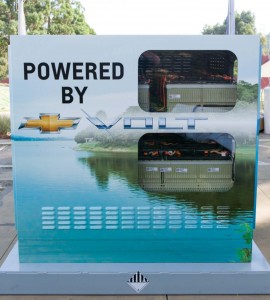
GM and ABB have partnered to develop this prototype power backup system using Chevy Volt battery packs.
If even the more moderate forecasts hold true, there could be millions of battery-electric vehicles on the road within the next decade. But what happens when they hit the end of their life? Glass, steel and even rubber can be recycled. But what about their high-tech batteries?
That’s what General Motors wants to find out. The maker is partnering with ABB, a leader in power generation and related technology, to see if there might be life after death for the batteries used in the Chevrolet Volt plug-in hybrid.
“In many cases, when an EV battery has reached the end of its life in an automotive application, only 30% or less of its life has been used,” said Pablo Valencia, the senior manager overseeing battery lifecycle management for GM. “This leaves a tremendous amount of life that can be applied to other applications like powering a structure before the battery is recycled.”
GM demonstrated one of the more promising possibilities during a two-day media seminar wrapped around the introduction of the new Chevrolet Spark EV which has an even larger battery pack than the 16 kilowatt-hours of lithium-ion cells in the Volt.
The project packages five used Volt battery packs in a weather-resistant module that can be located just about anywhere along the electric grid – but at the media briefing it powered much of the audiovisual gear, lighting and other needs for the various presentations.
Eventually, such a system would most likely be paired with one of the big transformers that typically provide electricity to anywhere from three to five typical American homes. Each module would provide on the order of 25 kilowatts of power – substantially less than a Volt’s battery pack might zap out under hard acceleration – and 50 kilowatt-hours of power.
The modular system could be used to offset grid brownouts or blackouts, much like the smaller uninterruptible power supplies, or UPS systems, many computer users now rely on.
“When the grid goes out, we’d be able to get through the majority of outages so customers wouldn’t see it at all,” said Dan Sowder, senior manager of new technology for Duke Energy, the utility that will join GM and ABB in testing the battery backup prototype.
The technology could also serve as a load balancing system, especially as utilities increase their reliance on renewable power sources such as wind or solar.
The problem is that renewables aren’t quite as steady and reliable as a big electric generator. But losing even a couple percent of the grid’s power can be disastrous, as Texas utilities discovered a couple years back when the state’s extensive wind farms were becalmed, cutting about 2% out of total generating capacity – and leading to rolling blackouts across the state until the wind started blowing again.
Having a way to smooth out the peaks and troughs of renewable generation is the “Holy Grail” utilities have been seeking, suggested GM’s Valencia.
Experts have begun to explore a variety of ways to utilize batteries to offset potential grid problems, including vast battery “farms” that could be set up nearby renewable systems or perhaps alongside factories and other high-demand electric users. The GM/ABB project suggests the concept could be scaled down to the point where even individual homes might one day be equipped with whole-house battery backup devices instead of the increasingly common gas or natural gas-fired backup generators.
“The ABB-GM Volt battery system is the world’s first use of car batteries as possible back-up power for homes and other commercial uses,” said Allen Burchett, ABB’s senior vice president for Business Development in North America. “We will be installing it on the grid soon to complete the technical evaluation, and this will tell us all what smart grid applications are possible, like back-up power, reducing energy cost, strengthening utilities’ distribution systems and storing surplus renewable energy.”
Not everyone is sold on the idea. The cost of battery power is still significant. The complete lithium-ion packs used in a Volt or Spark EV currently are estimated to cost north of $700 a kilowatt-hour once the battery cells, cooling system and other hardware is included. Prices are expected to fall sharply over the coming decade, however. And by turning to used batteries – which would still have more than enough life left – the price would fall to just a fraction of what new ones would cost.
The other issue is one of availability. By the end of this year, GM will have sold perhaps 30,000 Volts. The maker plans to have as many as 500,000 battery-based vehicles in use by 2017, though most will be lower-capacity hybrids. But the technology under study potentially could use batteries from other manufacturers, such as the packs in a Nissan Volt, a Ford Focus EV or a Honda Accord PHEV plug-in, officials noted.
But with the typical automotive propulsion battery expected to last 10 years, the numbers would likely be minimal until 2025 or beyond – except for those that might come available due to vehicle collisions or other problems.
If each of the new GM/ABB units handled five homes, that would work out to about one battery pack for each typical household. Even in a modest-sized city like Cincinnati, population 296,223, that would mean a lot of battery-cars would be needed to handle the demand.
So, realistically, if the utility industry hopes to develop a serious battery backup base it will likely have to find additional sources, especially near-term, though in the years and decades to come, the auto industry could become a vital partner.
That would be a big plus for makers like GM, meanwhile, said Valenica, noting that as sales of vehicles like the Volt and Spark EV increase, “It will be essential that we have a disposal plan in place for batteries at the end of a vehicle’s life.”
